Trash Talk Webinar - Wednesday November 15
What: Destination Medical Center Monthly Sustainability Series
When: Wednesday, November 15, 2023 | 12:00 pm -1:00 pm
Where: Viewable by webinar only. Join the presentation here.
If you're having difficulty "Launching the Meeting," try "Joining from Your Browser."
Details: Whether it’s household garbage, an old washing machine, or a can of paint, Olmsted County’s Integrated Solid Waste Management System provides a proper place for waste. Participants will learn about the unique services provided by the:
- Recycling Center Plus
- Hazardous Waste Facility
- Yard Waste Compost Site
- Waste-to-Energy Facility
- Kalmar Landfill.
Participants will also learn about the items that should and should not be placed in curbside garbage bins & recycling carts.
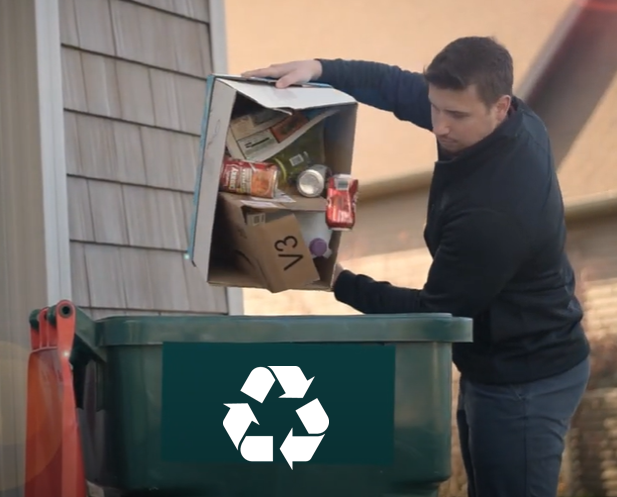 An Olmsted County resident recycles household items; photo credit: Nick Ryan
Recycling Right on America Recycles Day
America Recycles Day is recognized annually on November 15. And while we hope residents practice proper recycling habits all year long, this day provides a helpful reminder to make sure we're recycling right!
The following list of acceptable and unacceptable items was created with input from representatives of commercial waste haulers, materials recovery facilities (where recyclables get sorted) and solid waste educators/administrators from across Minnesota. That means the information is accurate regardless of who your hauler is.
Please note that the guide below is for residents with a curbside waste hauler. Those who self-haul to the Olmsted County Recycling Center Plus should review the facility's list of acceptable items online.
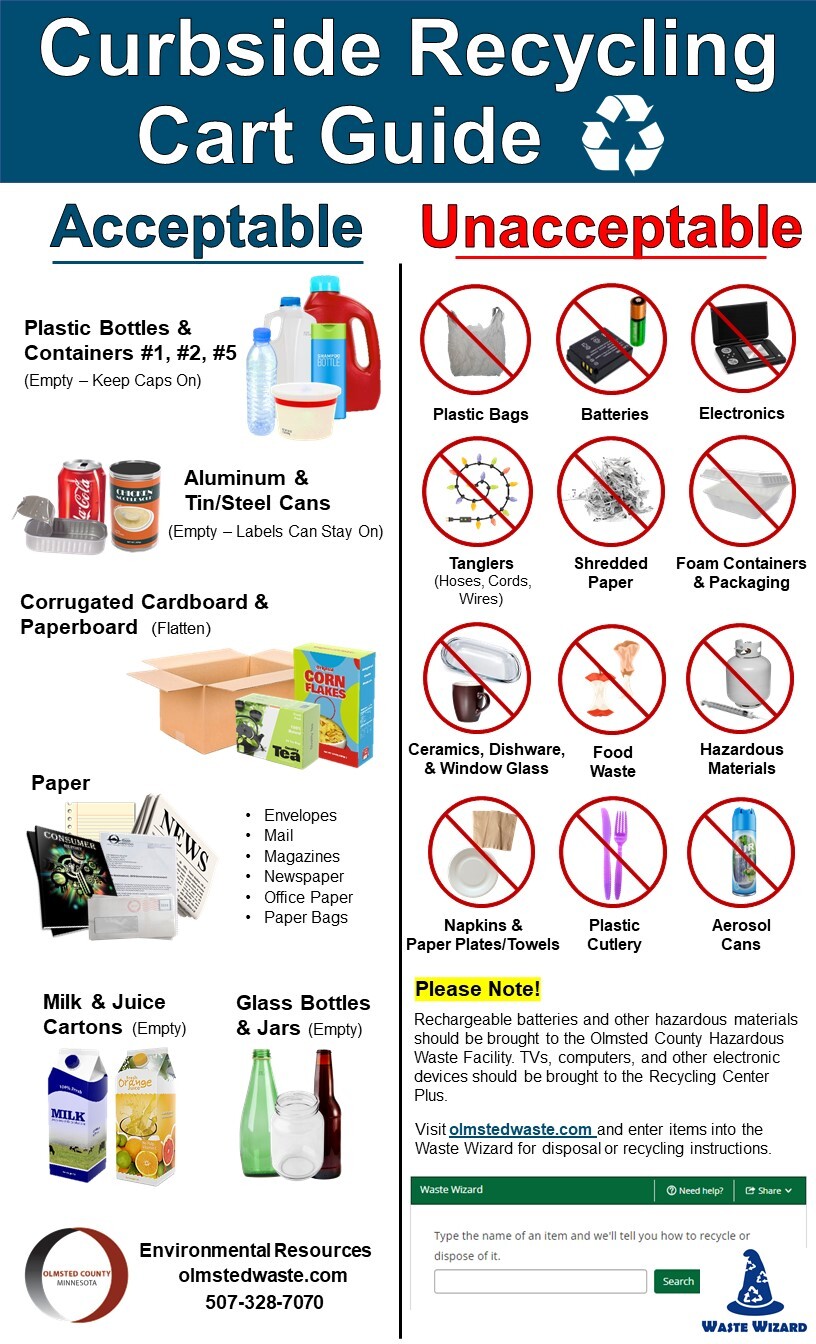
Mattress Recycling Update
Mattresses have historically presented disposal challenges for communities across the country. They can be difficult to work with and take up a lot of space in landfills. For about a decade, Olmsted County was shredding and back-hauling mattresses to the Olmsted Waste-to-Energy Facility where they were utilized as fuel.
While this was preferable to letting them take up space in their original form, shredding mattresses (specifically their coils) was particularly hard on our shredding equipment.
A better option was needed and eventually found at 7 Rivers Recycling in La Crosse, WI.
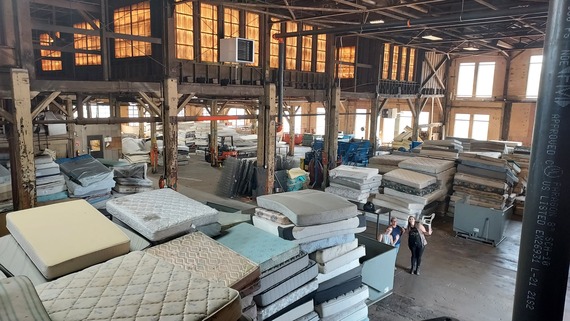 Mattresses stockpiled for recycling at 7 Rivers Recycling in La Crosse, WI; photo credit: Anthony Wittmer
Since the end of 2020, Olmsted County has shipped nearly 8,300 mattresses for recycling. As a result:
- Mattresses are moved further up the solid waste hierarchy. Steel mattress coils can be recycled. Mattress foam can be recycled into carpet backings. Mattress felt can be used as moving blankets, floor liners, and weed barriers.
- The life of shredding equipment at the Kalmar Landfill is prolonged.
- Handling at the Recycling Center Plus is reduced. An empty trailer is dropped off when a full load of mattresses is shipped.
- Recyclable material is kept out of the OWEF.
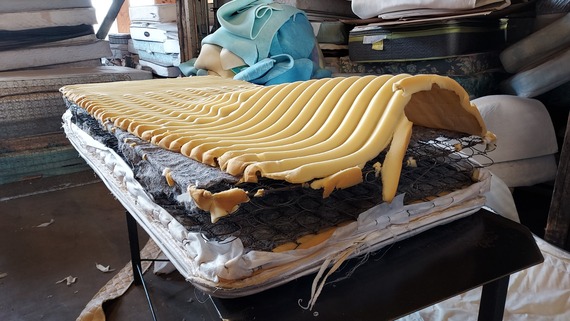 Mattress in the process of being disassembled; photo credit: Anthony Wittmer
Community Question: "Why does Rochester have so many waste removal companies...?"
In early October, a resident contacted the Rochester Post Bulletin Answer Man inquiring about the number of waste haulers in the community. To paraphrase, the resident wanted to know why so many different haulers operate in Rochester when other cities contract with one. Furthermore, the resident appeared to know our area's trash is processed at the Olmsted Waste-to-Energy Facility.
The Environmental Resources Department provided the following response—which has been condensed—to assist the Answer Man's research:
Olmsted County currently has an open-hauling system encouraging competition among multiple haulers. This approach was adopted in response to residents' concerns about the cost of residential trash hauling services, which had been influenced by limited competition.
Alternatively, cities within Olmsted County have the authority to contract with a specific number of haulers if they choose to do so.
Whether this approach "makes sense" varies from one community to another. Some communities prefer the competitive landscape multiple haulers create, while others may opt for a contracted arrangement.
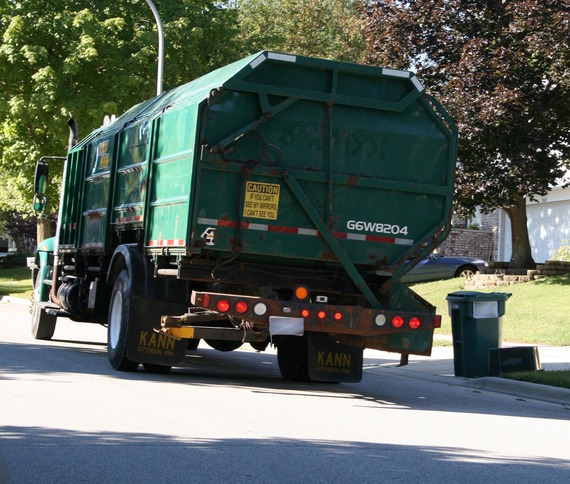 A waste hauler collects garbage from the curb; photo credit: Sharon Schriever
Recycling Center Plus Adds Aluminum Foil/Tins Recycling Cart
The Olmsted County Recycling Center Plus has added a recycling cart designated for aluminum foil and tins. These items should not be mixed in with the facility's aluminum beverage can bin. The Recycling Center Plus markets this material as aluminum scrap, provided the aluminum tins and foil are empty and clean.
Acceptable Items:
- Aluminum Foil (empty, clean, no food)
- Aluminum Tins (empty, clean, no food)
- Aluminum Trays (empty, clean, no food)
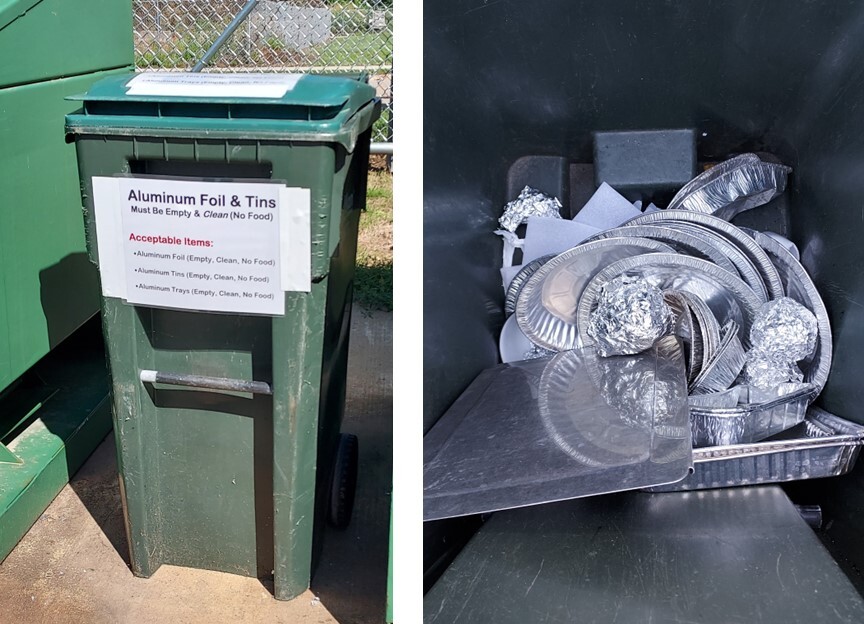 Aluminum foil/tin recycling cart at the Olmsted County Recycling Center Plus; photo credit: Anthony Wittmer
Compost Site Reminder
It's been another busy fall at the Olmsted County Compost Site. Over the past month, the site has received thousands of visits from residents and businesses alike.
Leaves make up the majority of material dropped off but the site also receives tons of garden waste (including hundreds of pumpkins). The majority of visitors do a great job of dropping off approved yard waste. Unfortunately, we are still receiving significant quantities of brush and tree debris. This does not break down in our composting process.
Additionally, we continue to see a considerable amount of plastic. For example, mums often have a plastic net embedded into the flowers/stems to help them keep their shape. The net, pot/container, and any other non-organic material should be removed and thrown in the garbage before you drop off the plant at the Compost Site.
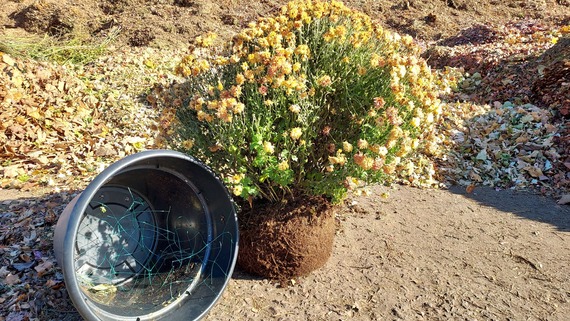 Potted plant at the Olmsted County Compost Site; photo credit: Anthony Wittmer
Disposal Discussion - Electric Toothbrushes
Disposal Question: "How should I dispose of an electric toothbrush?"
Answer: Electric toothbrushes contain rechargeable batteries (usually lithium-ion) and should be brought to the Olmsted County Hazardous Waste Facility (HWF). Both the electric toothbrush and power cord can be dropped off at no charge.
Lithium-ion batteries (LIB) can be particularly problematic. According to the Environmental Protection Agency (EPA):
"A damaged or defective LIB may experience thermal runaway, a reaction in which the battery unexpectedly releases its energy and begins self-heating in a runaway reaction. This reaction can quickly produce enough heat to ignite materials near the battery, even if the battery itself does not ignite. Though other types of batteries can experience thermal runaway, LIBs are particularly prone to combustion because they store such large amounts of energy."
You do not need to remove the rechargeable battery from the toothbrush before you bring it to the HWF.
Plastic brush heads can be thrown in the garbage.
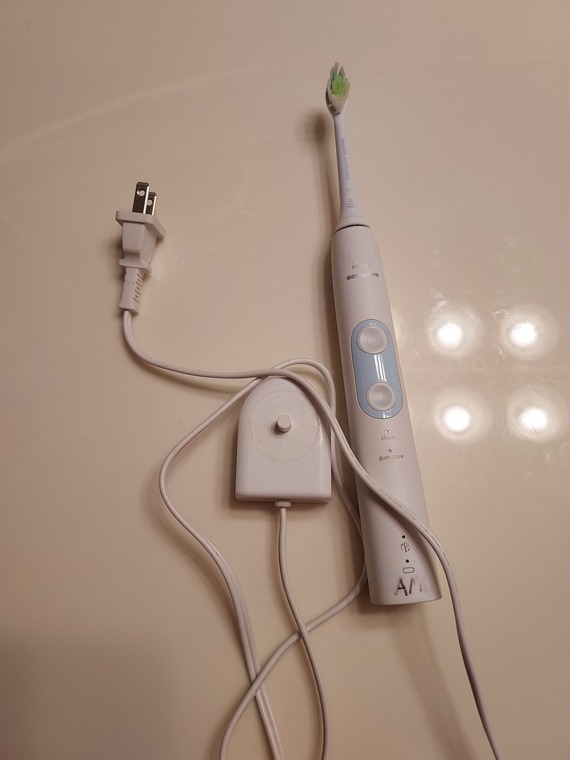 Electric toothbrush and charger; photo credit: Anthony Wittmer
|